Accounting for History: The Henrico County Historical Society celebrates 30 years of protecting the county's legacy - 01/12/2006
This article by Harry Kollatz, Jr. appeared in the December, 2005 edition of Richmond, The City Magazine. Photos by Adam Ewing.
When he was 12 years old, Wyndham resident Trevor Dickerson went on a family vacation. When they returned, an entire grove of trees and an old farmhouse on Church Road were gone. The experience showed him the value of history, preservation and planning. His interest led the current Deep Run High School junior to become the youngest member of the Henrico Historical Society (HHS), which this year is celebrating its 30th anniversary.
On a recent Sunday afternoon, tucked between the cul-de-sacs of a western Henrico County development off Gayton Road, an old house with a long history was being honored. The cooperation of neighbors, county officials and the HHS helped save the Nuckols Farmhouse (Locust Grove), built circa 1750. Now it can be appreciated in person instead of as a picture in a book with one of those dreaded descriptive captions, "Demolished, 2005".
The HHS was formed to prevent such events.
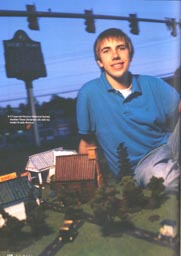
Under a sheltering tree, Dickerson presided over displays dramatizing the changes during recent decades to Western Henrico. He constructed a tabletop model of Short Pump as it looked in the 1930s to 1950s. It was an interesting scene considering the 17-year-old Wyndham resident has never lived in a world without Innsbrook. "I just started seeing things that would be torn down and they'd never be seen again," Dickerson said. "I figured, 'Why not document it?'"
His research pinpointed the location of the hamlet's original Motel 6, the Short Pump Tavern. Revolutionary War veteran Robert Hyde Saunders in 1815 purchased hundreds of acres along the Three Notched Road (Three Chopt Road) and at the intersection of the road and Deep Run Turnpike (Broad Street), building the two-story frame tavern, which was located at what is today the entrance to the Wal-Mart off Broad.
Dickerson and his mother, Linda, have explored miles of countryside lanes and knocked on unfamiliar doors of aged residents to ask simple questions about the way things were. This enterprising young man has put much of this information on an extensive web site (09/23/15: no longer maintained by its latest owners).
Mission Impossible
The HHS started with a phone call Jean Gibbons couldn't make. Localities throughout the country in the mid-1970s were creating committees to initiate their participation in the US Bicentennial of 1976. Gibbons wanted to form a Henrico commission, since with a settlement history dating to 1611, there was plenty of heritage from which to choose.
"The state Bicentennial Commission suggested that I call the county historical society to begin forming our own commission," Gibbons recalls, and laughs. "But there wasn't one."
She met with Aire Brandon, a member of the Varina Woman's Club, about the approval of the group's Bicentennial project. Gibbons also met with Louise Folye Baskett.
The Woman's Club, including Baskett and Gibbons, collaborated to start the group, and the first organizational meeting was held on Jan. 6, 1975, at the Varina Branch Library.
Dr. Henry Nelson, who joined soon after the group formed, notes that the society helped generate a book by Dr. Louise Manarin and Clifford Dowdey detailing the county's history.
"Many counties with less history than Henrico had formed societies," says Nelson. "We decided it was our turn."
Dowdey was a well-known historian of early Tidewater Virginia and the Civil War, and he agreed to write the book if Henrico resident Dr. Louise Manarin conducted the research. The University of Virginia Press published the book, The History of Henrico County, in 1984. The book is available in regional libraries today, and members of the society think it needs a revision.
The nonprofit HHS has through the years published more than books. They printed interpretive pamphlets, produced an annual magazine, and a quarterly newsletter. This year they published a guide to the county's private cemeteries.
Bold Souls Trudge On
HHS members Margaret Childress, Sue Krim and Ramona Anderson began exploring Henrico County's hidden and lost cemeteries in February 2000. This September, HHS printed a 100-page booklet that provides a tool for genealogists and historians alike with a listing of 3,000 graves.
Development continues to encroach upon forests and fields that were once part of farms or the sites of long-gone churches. A graveyard was found in the middle of Wellesley, and another was located off Route 1 near Virginia Center Commons.
"These women have gone on and climbed over fences and boulders and poinson ivy to find these places," says Vee Davis, a former president and convener of the HHS. "They're already updating it because people hear about it and keep giving them leads." (The book, Henrico Cemeteries, is $20 plus $5 shipping, available through the HHS treasurer, Dudley Lanthrip, (804) 795-5628.)
Saving Grace
Nelson, a charter member and past president of the HHS, compares efforts to rescue rare structures to trying to aid starfish stranded on a beach. "You can't save every one," he says, "but you're glad when you can get a few of them back into the water."
Fewer than a dozen pre-Civil War houses survive in Henrico. After 1960, Nelson says, the county lost more than 20 percent of its antebellum buildings through a combination of neglect and outright destruction. Caretaking for what remains falls to those who possess both appreciation and resources.
Cedar Hill, a middling farmer's house, began its third century at the entrance of Henrico's new Meadow View Park on Cedar Fork Road. It was moved through HHS prompting 400 feet on Nov. 15, 1999. Whatever its eventual use, the uprooted house can tell its story.
Days of Future Past
Linda Dickerson hopes that one day the association will have a home of its own, whether at Cedar Hill or Nuckols Farm. She says a fixed location would give the society some credibility. "The society is looked upon, by some people I think, as a few old folks plodding around cemeteries."
The challenge of meshing history with the present is never-ending. Young Trevor Dickerson presented an alternative plan for the Liesfield Farm on Broad across from Best Buy and Kroger. His proposal to the county supervisors preserved the farm's existing older structures. He explains, "Developers usually get what they want unless they can understand why these old places need to be preserved."
Linda Dickerson says that she's an unusual Wyndham resident because she's from Richmond. People move here and really don't take time to know the history or to feel connected," she says. "What's more frustrating is when you do find people who grew up here who don't care one bit about history. That's the saddest thing."
Redemption for an Old Place
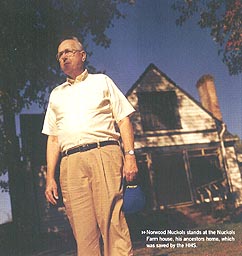
At the Nuckols Farm house, the floors are heart of pine, and a corkscrew stair and exposed beams can be found in the front room. It's an unadorned place, "We're not from the Carters, Randolphs or Byrds, the plantations along the James," Norwood Nuckols says. His ancestors were yeoman farmers who worked the land themselves without slaves. When Samuel Nuckols bought the farm in 1849 from the Ellis family, it was already a century old.
He relates how his earliest relatives, who arrived in 1650 from England, spelled the last name "Nuckolls." His Revolutionary War relative Wiliam "The Patriot" Nuckols, who performed commissary duties for the Continental Army, dropped the second "l" to distance himself from family members who chose loyalty to the Crown.
Nuckols has a browned scabbard containing the saber carried by his 19th-century grandfather Jacob Woodson Nuckols. The farmer left his crops, wife and children to ride with the 4th Virginita Regiment in J.E.B. Stuart's cavalry. Six generations of the Nuckols grew up here, and relatives and friends wandered its rooms, pointing out a missing wall here, a new door there.
Nuckols hadn't been inside himself for 30 years. Some who maintain interest in this house, though, never lived there. It's at 3501 Gayton Hills Lane, situated between two subdivisions that could've absorbed the property. Concerned residents instead appealed to Three Chopt District representative, David Kaechele, who arranged for land purchase. Through the cooperation of Kaechele, developer Skip Gelletly and the participation of the HHS, Nuckols Farm house is saved. It will be made a part of the county's park system, but comprehensive plans for its future are still being developed.
HHS president Sarah Pace explains that raising awareness is the most improtant mission of the group. "I don't think many people knew the value of the Nuckols house," Pace says. "it's a real survivor. And that does give us all a sense of accomplishment."
11/17/2007 Update: for further information, see Nuckols House in Three Chopt District.
>Back to Top<
Need for County Museum Piling Up; Limited Storage and Public View Prompt Call for Central Facility - 02/12/2006
This article by Jonathan Spiers appeared in the 01/27/2006 edition of the Henrico County Leader.
Out of public view in the basement of the Henrico Human Services Building, a treasure trove of historical artifacts, records and would-be museum exhibits fill nearly every square inch of the county's Historic Preservation and Museum Services department storage rooms.
And then some.
Assistant curator Alyson Rhodes-Murphy's office doubles as extra storage, with file cabinets of archive records and towers of boxes leaving her with just a slim walkway from the door to her desk, as well as an obstructed view of visitors in the hallway. A handwritten note on the door tells them, "I'm in here!"
And the three designated storage rooms are filled to the brim with artifacts from throughout Henrico's history, ranging from the respective 19th-century wardrobes of Meadow Farm's Dr. and Mrs. John Mosby Sheppard to the various kitchenware and knickknacks collected from one of the county's more recent acquisitions, the Clarke-Palmore House.
Space to store such treasures in one place is running out, if it hasn't already. And opportunities for the general public to view them are passing by.
Storage became more limited after Hurricane Isabel, when damaged facilities at Meadow Farm Museum required many items to be housed at the department. But natural disasters aside, space continues to lessen year after year because donations to the county are piling up, leaving staff with an abundance of artifacts and little room for them.
"It's frustrating, but we know it's not going unnoticed," said Kim Sicola, the county's curator for 15 years. "We're able to practice standard museum services. It's just tight, and it's difficult to access the collection. To help utilize the space we have is an enormous undertaking."
Granted, the county's collection is open for the public to view by appointment. But were it not for the firsthand knowledge of Sicola and Rhodes-Murphy, who care for and organize the items along with a humble staff of three other full-timers and three part-timers, navigating its inventory would prove a yeoman's task.
And were it possible for the county to have its own museum, says Beverley Davis of the Henrico Historical Society, a fuller appreciation for the history of Henrico could be had by the public while also alleviating the department's need for space.
"This department is so under-appreciated; most people don't know it exists under rec and parks," Davis said. "There's lots of items stored around that need to be consolidated. We need a repository for the artifacts and maps that are around different places."
Currently, Henrico is the only county in metro Richmond without its own museum. A pre-planning study has been listed on the division of recreation and parks' capital improvements plan for years, but funding has yet to be granted by county administrators. As the next budget season is getting underway, members of the historical society, along with the county's Historic Preservation Advisory Committee (HPAC), are pressing the Henrico Board of Supervisors to champion a study this year.
"It's obvious that a county that's as old as ours is needs a museum. It's the second oldest English settlement after Jamestown," Davis said. "We need to have a museum to have exhibits, but we also need space for classrooms and programs. We can use libraries, Meadow Farm, but we need bigger spaces."
Sicola acknowledges that space is at a premium throughout the division of recreation and parks, such as storage for props for theater productions or other special events. But for historical artifacts, a standard closet won't do, as most require climate-controlled conditions and the security of rooms that can be locked. The boxes piled high in Rhodes-Murphy's office alone contain years of documentation of each item's condition, which she said are not as efficient as they could be.
"It's a little bit more difficult to monitor the collection, and we can't get in the boxes and do the condition checks we'd like to do," Rhodes-Murphy said. "The condition is part of the artifact's history." Wes Malcomb, director of recreation and parks, said a pre-panning study for a museum remains a request of the division and will be presented for consideration for next year's budget.
"If it gets funded, we should know in the next four to six weeks," Malcomb said. "Everyone agrees that someday the county should have a museum because of its history."
"It's been an ongoing objective of the historical society and HPAC," added Henrico Supervisor Dave Kaechele of the Three Chopt District. He said county officials are eyeing a site near the future Four Mile Creek Park where Interstate 295 and Route 5 intersect in Varina as a potential home for a museum and countywide information center.
"The first step would be to get some proposals or a study of the cost to build it and operate it," Kaechele said. "Getting the funding is going to be the biggest challenge. There are capital projects that get higher priority, such as schools and roads."
HPAC chairwoman Vee Davis wrote a letter to the board of supervisors in November requesting $40,000 for the pre-planning study. She said HPAC encourages the county to construct a museum by 2011.
"The HPAC committee for several years now has been thinking that Henrico County, being so rich in history as it is, should have a place to see that, and where the story of Henrico can be told - a place people can visit," she said. "The board knows Historic Preservation and Museum Services is having a storage problem because of so many artifacts and donations. A proper museum would be a good place to store those things, not only for viewing but also for storing. This study we requested is the first step."
Even if county administrators recommend funding a study this year, years would remain before an actual Henrico museum would see the light of day. Until then, the county's museum services staff continues to accept every donation of history sent the department's way. But the question of where to put it all will continue to be asked.
"I feel like we are the museum," Sicola said. "I would love to see a more ideal system for itemizing and storing, and to have it all in one place. And I guess it would be good for visibility. Without a museum, you don't have a separate identity [from recreation and parks]. We benefit from parks' services - they do a lot. But Henrico has such a rich history that it does make sense to have a museum."
>Back to Top<
Gone For Good? Springfield Baptist Site May Be Demolished Soon - 02/15/2006
This article by Patty Kruszewski appeared in the 02/10/2006 edition of the Henrico Citizen and can also be found online at Richmond.com.
Liesfield farm, western Henrico's iconic pasture, is barely a memory now - or at least devoid of cows and poised for retail development.
And with its disappearance and looming commercialization, Short Pump loses the last remnant of its rural heritage and last hold-out against creeping sprawl.
Or does it?
Tucked behind a shopping center across Broad Street from the pastoral scene is a reminder of the community's simple beginnings that few neighbors - other than shoppers at Best Buy and Kohl's - ever see.
Until recently the home of Springfield Baptist, an African-American church built in 1887, the building has been deemed inadequate by its growing congregation.
"When I came here in December 2002," says the current minister, Proctor Beard, "it was my understanding that the church had decided they needed to relocate. With the influx of young adults and new members, realistically, the facility was not conducive to a progressive ministry."
Hemmed in by Interstate 64 and Broad Street's commercial corridor, the church had no room to remodel or add on, and sold the property to Atlantic Development in March 2004 - with stipulations that services could continue in the building for six months, and that developers would build protective fencing for the graveyard left behind.
The congregation is currently worshipping at J.R. Tucker High School until a new church can be built.
Worth Saving
Although he has been with the church only a short time, Rev. Beard is familiar with its history and would like to see the building preserved.
"Even if we couldn't use it for contemporary services, I'd like to see a memorial or a museum where we could do meetings or socials," he says. "The building was built by hand by grandparents of members I have now. It used to sit on the ground, 'til the men of the congregation lifted it onto blocks."
Trevor Dickerson, a young preservationist who has been documenting Short Pump's history since 1999, would also like to see the building saved. The awkward location, Dickerson believes, only adds to the church's value. In a January e-mail alert to members of the Henrico County Historical Society (HCHS), Dickerson said he had driven by the site and noticed a dumpster in the parking lot - "probably a sign that [developers] are about to tear it down.
"That church is just too unique and in an even more unique location behind all the retail development," writes Dickerson. "But it's in a spot that I think could be salvaged because it backs up to the interstate and is behind other development rather than on prime roadfront property."
Linda Dickerson, first vice president of HCHS (and Trevor's mother), points out that at one time county staff appeared interested in preserving the church.
A Planning Commission staff report in 2003 noted that the church is listed in the Virginia Department of Historic Resources Architectural Survey, and is one of approximately nine late-19th and early-20th century churches in the county. An earlier development plan actually called for converting the building into a pizza parlor.
"Even though that seems an odd use for an old church building," Trevor says, "they would have preserved the integrity of the structure with only minor modifications."
But Linda Dickerson adds that another report in October 2004 said, "The Division of Recreation and Parks staff now requests to have access to the interior and exterior of the church prior to any demolition to photo-document the structure."
Larry Willis of Atlantic Development recently told the Henrico Citizen that the company does have demolition rights, and is mulling plans for a hotel, retail shops or restaurant on the site. But consideration would be given to anyone willing to move the church off-site for preservation's sake.
"It's sitting on a block foundation," Willis said, "if someone's looking to buy it."
Some Keepsakes Remain
Even if the entire church cannot be preserved, says Rev. Beard, he hopes to receive enough prior notice of demolition to save key pieces.
"We took the sign that was in front of the church," Beard says, "and was given to the church by grandparents of some members. And we installed it at our temporary administrative office [at 3205] Skipwith [Road].
"We could use the [old] bricks to build a wall; or save the windows for a library or chapel [in the new building]. And we'd like to get the bell from the tower . . . but it's expensive to fetch." The bell has historic significance, the minister says, because it called the people to worship for generations - from the days when an old dirt road led to the church, and a sign was needed to point the way because trees were too thick to allow a view from Broad Street.
"I'm unhappy that the county seemed to write this building off as not valuable enough to preserve," says Trevor Dickerson, who in 2002 was the youngest recipient ever of Henrico's Historic Preservation Advisory Committee Award of Merit. "The county at the very least should do a good interior documentation.
"I know it's impossible to save every site, but I think there need to be tougher codes and regulations to govern the loss of these special places."
11/17/2007 Update: for further information, see Springfield Baptist Churck in Past Preservation.
>Back to Top<
HCHS President's Message - 02/26/06
Recently, after traveling north on Parham Road in a steady stream of traffic through several stop lights, I glanced to the right on Lydell Road and noticed the open fields of a farm. It was a little early yet for the fields to be plowed since it was after all just January but there were remnants on the ground of what appeared to have been a corn crop from the previous growing season. In the distance were the barns and located
not far from those was the farmhouse.
It struck me that at one time what would have seemed to be just an ordinary site has become in the western portion of Henrico County quite an unusual site. I had almost forgotten how pleasing and what a calming effect a pastoral view could have. In the hustle and bustle of every day life we may not have noticed that the farms and open land have been quietly disappearing from the landscape.
We would like to begin this New Year with a renewed dedication to the mission of this Society:
(1) The purpose of this Society shall be to bring together people interested in history, especially the history of Henrico County in Virginia.
(2) The major function will be to discover and collect any material which may establish or illustrate the history of the area: its exploration, settlement, development and activities in peace and in war.
(3) The Society will cooperate with public bodies in preserving and making accessible archives of the County, its communities, towns, and institutions, and will promote the identification and preservation of historical artifacts, sites, structures, roadways and streams.
(4) The Society will disseminate historical information with publications, meetings with lectures and discussions, tours, the marking of sites, and by the use of all means of awakening public interest.
On another note, I am pleased to welcome two new members to the Executive Board, Ruth Ann Kramer and Louis Campbell. Ruth Ann will be in charge of Publicity. She volunteered and did a splendid job of distributing programs and selling tee shirts for the Nuckols Farm project. In her own words, she supports the preservation of history in Henrico County.
Louis Campbell will be our new newsletter editor.
Louis grew up in Henrico County and recently moved back to Richmond from Charleston, SC. Louis received his BA in English from Virginia Tech and a MA in History from the College of Charleston and the Citadel, focusing on colonial and antebellum southern history.
I have had great fun writing the newsletter since Bev Davis gave up the job after her many years of dedicated service. I apologize for rusty writing skills and now turn the print over to Louis. I think he will make a top notch editor.
We look forward to an exciting New Year.
Sarah Pace
President
>Back to Top<
HCHS Appreciation Reception Held 12/12/2005 - 02/26/06
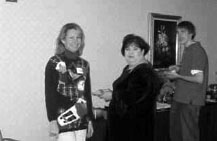
On December 12, 2005 a reception was given by HCHS in appreciation for those who participated in the Nuckols Farm Benefit at Our Lady of Hope. Michelle Keller is a neighbor of Nuckols Farm and was among the first along with April Sullivan, another neighbor, who appealed to the county to save Nuckols Farm. Michelle served as corporate liaison and April served as publicity contact for the project. We appreciate their hard work and dedication, as well as all others who participated in the effort to save Nuckols Farm.
>Back to Top<
The Association for Preservation of Henrico Antiquities
President Henry Nelson reports that there are negotiations with Wilton Development under way to move the Leake House on Pouncey Tract Road to save it from destruction. Another APHA project has completed the restoration of the wall surrounding the Randolph Family Cemetery on Turkey Island.
The County of Henrico Public Relations and Media Services are filming a documentary on the Randolph Cemetery that will include the results of the project to be shown later on HCTV, Channel 19.
APHA will also present a symbolic key to Springfield Farmhouse to the County of Henrico for possible reconstruction in Dorey Park.
The next APHA meeting will be held Thursday, March 17, 2006 at the Henrico County Human Services Building, 8600 Dixon Powers Drive, 7 p.m. Visitors are welcome.
>Back to Top<
Henrico Theatre Receives National Recognition; County Working To Restore, Repopen Historic Movie House - 02/26/06
This article by Jonathan Spiers appeared in the 01/13/2006 edition of the Henrico County Leader.
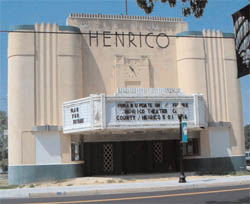
When the Henrico Theatre opened in Highland Springs in the spring of 1938, its modern look, 1920s Art Deco design and lavish quality amenities were met with a reception in the community deserving of its grandiose appearance.
Richmonders flocked to the area's newest attraction to see the silver screen's latest attractions. Tickets cost a quarter per adult, a dime per child, and many a movie would be screened there for over 60 years before closing its doors in 1996.
Today, county officials are inching near completion of an ongoing effort to restore the now publicly owned theater to its former greatness, spurred most recently by its inclusion on the National Register of Historic Places.
The recognition came in mid-September last year, making the theater the 24th historical site in Henrico County to be included on the national register. The honorary title serves as one step toward ensuring the preservation of the structure, acknowledged
as the most prominent and historically significant example of Art Deco architecture in the county.
Among the projects approved by county residents in last year's bond referendum, the Henrico Theatre restoration is slated to receive construction funds this summer, and officials are aiming to complete work and reopen the building as an active movie theater and performing arts venue by fall 2007. The project is also a cornerstone of the county's revitalization plan for Highland Springs and the Nine Mile Road Corridor.
"It's a facility that dates back to the 1920s and has meant a lot to the Highland Springs community and all of Henrico County," said Wes Malcomb, director of recreation and parks. "When you can adapt it for use today, it's a great opportunity."
Designed by local architect Edward Francis Sinnott, the two story Henrico Theatre stands out dramatically from adjacent buildings along Nine Mile Road, due in large part to its curved,poured-concrete façade, protruding marquee and stylized "Henrico" name etched above its front.
The theater is so noticeably different in style compared to its small-town, rural surroundings that it seems dramatically out of place. No accident, says architectural historian Bryan Clark Green, who describes the original intent of the theater as an effort to attract the attention of moviegoers and city residents, alike. Green and fellow historian Susan Reed of Richmond-based Commonwealth Architects prepared the county's national register application for the property.
"It's not a subtle design. It shows that the county saw itself as up-and-coming," Green said. "The county was trying to draw attention, absolutely competing with the other heaters in Richmond such as the Byrd and the National - to really assert itself with that group of theaters."
Green describes the Art Deco style as streamlined, as being one of movement, in which the structure itself makes a statement without additional flair or ornamentation.
"It was a very conscious statement," he said of the theater's design. "Film was technologically advanced at the time - the whole idea of streamlining, that you could have news reels flown in and shown - [the design] gave the impression of wanting to 'take off.' You always imagine an Art Deco building as flying or moving. There's nothing like it in this part of the state."
While the exterior of the building has generally kept its original appearance, the theater's interior - once comprised of what were then the most state-of-the-art features available, such as air-conditioning, high-quality lighting and projection equipment, cushioned seats, and plush fabric - has aged but for the most part is in good condition.
"It's in really good shape," Green said. "It's a really well-constructed building. They were not holding back on this building. The lobby is in good shape, and it has really wonderful door hoods, which are just stunning."
While county officials continue to work toward revealing the Henrico once again to the public for inspection, interpretation and active use, the structure itself, both inside and out, represents a form of architecture not as easily found in the Richmond metro
area. For a local lesson in Art Deco design and the history of Highland Springs, Green says, one need only look to the Henrico. "There's really nothing else like that." Art Deco, Green said, "It's a really small class of thing." The Henrico, he added, "It's a great example. It really shows you what you need to know."
>Back to Top<
In Memorium - Anna Massey DeVilbiss, Owner of Historic Whichello. - 02/26/06
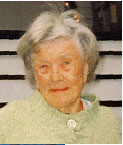
Anna Massey DeVilbiss was the widow of James Donald DeVilbiss. Born on November 18, 1905, she was 100 years old. She lived for over 50 years at her historic home, “Wichello” located in Henrico County. Mrs. DeVilbiss, a triplet, was the last surviving member of the seven children of Sarah Jane Evans Massey and A. T. Massey, founder of A. T. Massey Coal Company, now Massey Energy. She was a graduate of the Collegiate School and the Class of 1927 at Westhampton College of the University of Richmond. She received he accredited teaching certificate and taught in public high schools in Virginia and West Virginia. Mrs. DeVilbiss was an honorary member of the Richmond Council of Garden Clubs, a nationally accredited flower show judge, an honorary member of the River Road Garden Club and a charter and board member of the Henrico County Historical Society. She was a member of The Country Club of Virginia, Deep Run Hunt Club and a former member of Fishing Bay Yacht Club. Mrs. DeVilbiss was a communicant of St Mary’s Episcopal Church in Goochland County where she served on the Alter Guild and taught Sunday School. She is survived by her son,
Antonv Massey DeVilbiss; her daughter, Mary Catherine DeVilbiss Moomaw, both of Richmond; three grandchildren, Anna Massey Rudisill of Charlotte, N.C., Mary Robertson Thorne of Newnan Ga. and Benjamin Franklin Moomaw V of Richmond; and two great-granddaughters, Mary Kellison Thorne and Sarah Evans Massey Thorne.
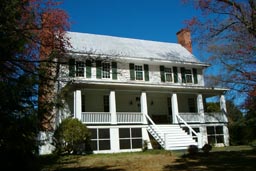
Also known as the "Tall House", Whichello stands today on a tract of land on River Road that belonged to the Randolph family of Tuckahoe in the early 19th century. Later a Frenchman named Druin, reported to be the barber of one of the Randolphs, acquired the land and passed it to his daughter Catherine, widow of Charles Woodward. In 1838, Catherine's daughter, Eliza Anne Woodward Winston, sold the property to Richard Whichello, who operated a tavern here. The present dwelling is thought to have been erected in 1827 by Catherine Woodward, but Whichello could have built it somewhat later.
Local tradition portrays Whichello as a greedy entrepreneur who supplemented his income by engaging his patrons in rigged games of chance. In 1850, a cattle drover murdered Whichello after he lost a large sum of money to him in a card game. Many legends surround the former home of Richard Whichello as the result of his untimely death.
After the most recent ownership of over fifty years, the property will continue to be maintained by the DeVilbiss family.
11/17/2007: for further information, see Whichello in Tuckahoe District.
>Back to Top<
News 2006: First Quarter
Second Quarter | Third Quarter | Fourth Quarter
Home | Henrico | Maps | Genealogy | Preservation | Membership | Shopping | HCHS
|











